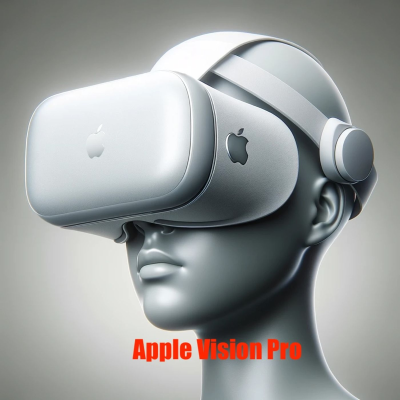
Apple Vision Pro
Podcast by 2024 Quiet Please
This podcast is free to listen on all podcast players and the Podimo App without a subscription.
All episodes
3 episodesApple's Vision Pro May Launch in China Under Different Name Due to Trademark Issues It appears Apple's new Vision Pro headset may go by another moniker when it eventually launches in China. According to a recent report, Apple could be prevented from using the Vision Pro name in China due to Huawei successfully registering it as a trademark back in 2019. The report, originating from Chinese supply chain sources, suggests Apple is aiming to release Vision Pro in China between April and May 2023. This aligns with recent hints from Apple CEO Tim Cook that a China launch would happen "soon" after the initial US product rollout this spring. However, because Chinese electronics giant Huawei holds a current 10-year Vision Pro trademark applicable to VR headsets and related display products awarded in 2021, legal experts state Apple could risk infringing intellectual property rights by debuting their mixed reality headset under that exact same name in the region. While Vision Pro trademarks exist in numerous countries worldwide registered to various companies, China's court system in particular has displayed favoritism rulings benefiting local firms in past tech IP disputes against foreign competitors. For example, a questionable 2016 judgment temporarily barred Apple from selling certain iPhone models in China over trademark disagreements. That decision was later reversed but illustrates risks Vision Pro could temporarily encounter regulatory obstacles tied to branding there. My instinct is that any potential naming hurdle likely poses a relatively minor complication for Apple launching an eventual blockbuster consumer electronics device into its second-largest national market. Even if Vision Pro as a product name remains disputed for months and embroiled in legal appeals, Apple could likely still introduce the hardware under a different moniker unique to China without severely impeding enthusiasm or preorders and then market it, as Vision Pro elsewhere globally. This "when in China, do as the Chinese" workaround could help Apple elegantly sidestep any trademark injunctions Huawei pursues over the contested Vision Pro name, just as Apple weathered past iPhone branding headwinds there through temporary regional rebrands before. Given Tim Cook's vocal advocacy about China's significance in driving Apple's future ambitions as sales growth driver despite regulatory tensions, we can expect Apple putting steadfast effort into ensuring swift China availability for their landmark headset even if Vision Pro branding itself requires short-term substitutes placating legal or political objections. Early April and May release timeframes may still hold regardless of initial naming uncertainties. Thanks for listening to Quiet Please. Remember to like and share wherever you get your podcasts. And Hey! History buffs, buckle up! Talking Time Machine isn't your dusty textbook lecture. It's where cutting-edge AI throws wild interview parties with history's iconic figures. In the Talking Time Machine podcast: History Gets a High-Tech Twist. Imagine: Napoleon Bonaparte talking French Politics with Louis the 14th! This podcast is futuristically insightful. Our AI host grills historical legends with questions based on real historical context, leading to surprising, thought-provoking, and often mind-blowing answers. Whether you're a history geek, a tech junkie, or just love a good interview, Talking Time Machine has something for you. Talking Time Machine: search, subscribe, and (Listen Now!)
Holomedicine has the potential to profoundly transform healthcare by leveraging spatial computing technologies like Apple's Vision Pro. Specifically, holograms could revolutionize surgery, patient consultations, and medical training. In surgery, overlaying 3D projections of a patient's anatomy would significantly enhance visualization and enable minimally invasive procedures with pinpoint accuracy. Vital signs, scans, and records could be displayed within the surgical field to optimize information access and decision-making. Preoperative planning would also be enhanced through virtual rehearsals with patient-specific 3D models. Patient consultations could become highly engaging, personalized experiences through holographic telemedicine. Doctors could project themselves into patients' homes to foster meaningful doctor-patient relationships. Patients could also interact with 3D models to better comprehend their conditions. Demonstrating procedures through holograms would simplify patient education as well. For medical students, holographic simulations would enable immersive training experiences not possible today. Students could dissect virtual cadavers, practice procedures on holographic patients, and collaborate with peers in shared virtual environments. This could accelerate skill development and better prepare students for real-world practice. However, realizing the full potential of Holomedicine requires overcoming key challenges like managing costs, ensuring data security and patient privacy, and thoughtfully integrating the technology into existing clinical workflows. Careful planning is also needed to provide equitable access to underserved communities. By addressing these hurdles, holograms could eventually become ubiquitous in hospitals, clinics, and classrooms - making surgery safer, consultations more personalized, and medical training more effective. Holomedicine promises a brighter future for healthcare, and it will take a concerted effort across medical, technology, and policy domains to fully deliver on that promise. Thanks for listening to Quiet Please. Remember to like and share wherever you get your podcasts.
Apple Vision Pro Explained: A Dive into the Future of Computing Apple's Vision Pro, launched in June 2023, isn't just a new gadget; it's a bold foray into the world of spatial computing. Unlike traditional computers confined to screens, Vision Pro seamlessly blends digital content with the physical world, creating an immersive and intuitive experience. But what exactly is it, and what does it offer? Let's delve deeper. Beyond the Screen: Spatial Computing Explained Spatial computing, Apple's term for the technology behind Vision Pro, goes beyond flat displays. It projects digital information directly into the real world, allowing users to interact with 3D objects and information within their physical space. Imagine manipulating holograms on your desk, playing augmented reality games that come alive in your living room, or collaborating with colleagues as if they were present, even if they're miles away. That's the promise of spatial computing. Vision Pro: Unveiling the Possibilities Vision Pro itself resembles a high-tech pair of goggles, equipped with advanced displays, cameras, and sensors. These components work together to: * Project high-resolution visuals: Imagine crisp, vibrant content floating in front of you, seamlessly integrated with your surroundings. * Track your eye movements and hand gestures: Vision Pro interprets your gaze and hand motions as natural controls, allowing you to manipulate holograms and navigate the virtual world intuitively. * Map your physical space: Cameras and LiDAR sensors create a 3D understanding of your environment, enabling spatial interactions with digital objects. * Connect with others: FaceTime calls transform into life-size, holographic interactions, fostering a sense of presence even in virtual spaces. Key Features and Capabilities Vision Pro boasts several groundbreaking features: * Spatial Photos and Videos: Capture 3D memories that come alive when viewed on Vision Pro or compatible devices, offering a deeper level of immersion. * EyeSight: Lets you maintain eye contact with others while using Vision Pro, fostering social connection even in the virtual world. * Persona: Creates a realistic digital avatar that reflects your facial expressions and hand movements during FaceTime calls, enhancing the sense of togetherness. * VisionOS: The dedicated operating system designed for spatial computing, offering intuitive controls and a unique 3D user interface. A Glimpse into the Future, But Not Without Hurdles Vision Pro represents a significant leap forward in human-computer interaction. However, it's still in its early stages. Some potential challenges include: * Limited app ecosystem: As a new platform, Vision Pro currently lacks a vast app library compared to established devices. * Price and accessibility: With its advanced technology, Vision Pro comes at a premium price, potentially limiting its widespread adoption. * Privacy concerns: Integrating cameras and sensors into such a personal device raises privacy questions that need careful consideration. Conclusion: A Transformative Tool, Still Evolving While Apple Vision Pro may not be for everyone yet, it marks a pivotal moment in the evolution of computing. Its innovative design and capabilities showcase the immense potential of spatial computing to change how we interact with the world around us. As technology advances and these challenges are addressed, Vision Pro and its successors could become mainstream tools, transforming the way we work, connect, and experience the world. Thanks for listening to Quiet Pleas. Remember to like and share wherever you get your podcasts.
Available everywhere
Listen to Podimo on your phone, tablet, computer or car!
A universe of audio entertainment
Thousands of audiobooks and exclusive podcasts
No ads
Don't waste time listening to ad breaks when listening to Podimo's content.



















